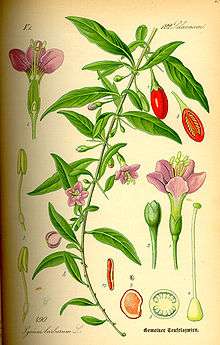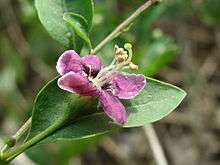Lycium barbarum
| Lycium barbarum | |
|---|---|
| | |
| Lycium barbarum fruits | |
| Scientific classification | |
| Kingdom: | Plantae |
| Clade: | Angiosperms |
| Clade: | Eudicots |
| Clade: | Asterids |
| Order: | Solanales |
| Family: | Solanaceae |
| Genus: | Lycium |
| Species: | L. barbarum |
| Binomial name | |
| Lycium barbarum L. | |
| Synonyms[1] | |
| |
Lycium barbarum (simplified Chinese: 宁夏枸杞; traditional Chinese: 寧夏枸杞; pinyin: Níngxià gǒuqǐ) is one of two species of boxthorn in the family Solanaceae from which the goji berry or wolfberry is harvested, the other being Lycium chinense (Chinese: 枸杞; pinyin: gǒuqǐ). It is native to southeastern Europe and Asia.[2]
It is also known as Chinese wolfberry,[3] Chinese boxthorn,[3] Himalayan goji,[3] Tibetan goji,[3] mede berry, barbary matrimony vine,[3] Duke of Argyll's tea tree,[3] Duke of Argyll's tea plant,[3] Murali (in India),[4] red medlar[5] or matrimony vine.[3]
Description

L. barbarum is a deciduous woody perennial plant, growing 1–3 m high. It is grown in North China, primarily in the Ningxia Hui Autonomous Region.
Leaves and flower

L. barbarum leaves form on the shoot either in an alternating arrangement or in bundles of up to three, each having a shape that is either lanceolate (shaped like a spearhead longer than it is wide) or ovate (egg-like). Leaf dimensions are 7-cm in length by 3.5-cm broad with blunted or round tips.
The flowers grow in groups of one to three in the leaf axils. The calyx (eventually ruptured by the growing berry) consists of bell-shaped or tubular sepals forming short, triangular lobes. The corolla are lavender or light purple, 9–14 mm wide with five or six lobes shorter than the tube. The stamens are structured with filaments longer than the anthers. The anthers are longitudinally dehiscent. Plants are self-pollinating, but may be cross pollinated by insects. In the northern hemisphere, flowering occurs from June through September and berry maturation from June to October, depending on the latitude, altitude, and climate. where frost does not occur fruiting is continuous and plants do not lose their leaves.
Fruit
L. barbarum produces a bright orange-red, ellipsoid berry 1–2-cm deep. The number of seeds in each berry varies widely based on cultivar and fruit size, containing anywhere between 10–60 tiny yellow seeds that are compressed with a curved embryo. The berries ripen from July to October in the northern hemisphere.
Etymology
Lycium, the genus name, is derived from the ancient southern Anatolian region of Lycia (Λυκία).[6] The fruit is known in Traditional Chinese medicine references as Fructus Lycii, which is Latin for "Lycium fruit".
In the English-speaking world, the name "goji berry" has been used since the early 21st century. The word "goji" is an approximation of the pronunciation of gǒuqǐ (枸杞), the name for the berry producing plant in several Chinese dialects, including Hokkien and Shanghainese. This name possibly derives from the same roots as the Persian language term gojeh (گوجه) which means "plum/berry".
Other common names are "the Duke of Argyll's Tea Tree"[3] and "matrimony vine".[3]
In Tibetan the plant is called dretsherma (འདྲི་ཚིར་མ། ![]() ), with dre meaning "ghost" and tsherma meaning "thorn".
), with dre meaning "ghost" and tsherma meaning "thorn".
Cultivation
China
The majority of commercially produced wolfberries come from the Ningxia Hui Autonomous Region of north-central China and the Xinjiang Uyghur Autonomous Region of western China, where they are grown on plantations. In Zhongning County, Ningxia, wolfberry plantations typically range between 40 and 400 hectares (100–1000 acres or 500–6000 mu) in area. As of 2005, over 10 million mu have been planted with wolfberries in Ningxia.[7]
Cultivated along the fertile aggradational floodplains of the Yellow River for more than 600 years, Ningxia wolfberries have earned a reputation throughout Asia for premium quality sometimes described commercially as "red diamonds".[8] Government releases of annual wolfberry production, premium fruit grades, and export are based on yields from Ningxia, the region recognized with
- The largest annual harvest in China, accounting for 42% (13 million kilograms, 2001) of the nation's total yield of wolfberries, estimated at approximately 33 million kilograms (72 million pounds) in 2001.
- Formation of an industrial association of growers, processors, marketers, and scholars of wolfberry cultivation to promote the berry's commercial and export potential.
- The nation's only source of therapeutic grade ("superior-grade") wolfberries used by practitioners of traditional Chinese medicine.[9]
In addition, commercial volumes of wolfberries grow in the Chinese regions of Inner Mongolia, Qinghai, Gansu, Shaanxi, Shanxi, and Hebei. When ripe, the oblong, red berries are tender and must be picked carefully or shaken from the vine into trays to avoid spoiling. The fruits are preserved by drying them in full sun on open trays or by mechanical dehydration employing a progressively increasing series of heat exposure over 48 hours.
Wolfberries are celebrated each August in Ningxia with an annual festival coinciding with the berry harvest.[7] Originally held in Ningxia's capital, Yinchuan, the festival has been based since 2000 in Zhongning County, an important center of wolfberry cultivation for the region.[7] As Ningxia's borders merge with three deserts, wolfberries are also planted to control erosion and reclaim irrigable soils from desertification.[10]
China, the main supplier of wolfberry products in the world, had total exports generating US$120 million in 2004. This production derived from 82,000 hectares farmed nationwide, yielding 95,000 tons of wolfberries.[8]
Pesticide and fungicide use
Organochlorine pesticides are conventionally used in commercial wolfberry cultivation to mitigate destruction of the delicate berries by insects. Since the early 21st century, high levels of insecticide residues (including fenvalerate, cypermethrin, and acetamiprid) and fungicide residues (such as triadimenol and isoprothiolane), have been detected by the United States Food and Drug Administration in some imported wolfberries and wolfberry products of Chinese origin, leading to the seizure of these products.[11]
China's Green Food Standard, administered by the Chinese Ministry of Agriculture's China Green Food Development Center, does permit some amount of pesticide and herbicide use.[12][13][14] Agriculture in the Tibetan plateau (where many "Himalayan" or "Tibetan"-branded berries originate) conventionally uses fertilizers and pesticides, making organic claims for berries originating here dubious.[15]
United Kingdom
The Duke of Argyll introduced Lycium barbarum into the United Kingdom in the 1730s where it is known as Duke of Argyll's Tea Tree.[3] It was and still is used for hedging, especially in coastal districts. Its red berries are attractive to a wide variety of British birds.[16]
The plant continues to grow wild in UK hedgerows. On 15 January 2003, the Department for Environment, Food and Rural Affairs launched a project to improve the regulations protecting traditional countryside hedgerows, and specifically mentioned Duke of Argyll's Tea Tree as one of the species to be found growing in hedges located in Suffolk Sandlings, Hadleigh, Bawdsey, near Ipswich, and Walberswick.[17]
On June 18, 2007, the FSA (UK Food Standards Agency) stated that there was a significant history of the fruit being consumed in Europe before 1997, and has removed it from the Novel Foods list.[18] It is now legal to sell the wolfberry in the UK as a food as reported by the British Food Standards Agency,[19] but see section in the Goji article on Marketing claims. United States Lycium barbarum has become a high demand plant in the United States. Nearly all major nursery catalogs now carry plants and there are many suppliers found on various web sites. There are a number of varieties available, ranging from leaf producing plants to fruit producing varieties. Most listed plants are hardy zones 5-9. One variety, Phoenix Tears is hardy zones 3-10. This variety produces fruit year round in warmer climates. The nutrient profile of both leaves and fruit is well documented on this variety. Berries and leaves produced in the United States are probably more pesticide free than those produced in China.
Importation of mature plants
Importation of Wolfberry plants into the United Kingdom from most countries outside Europe is illegal, due to the possibility they could be vectors of diseases attacking Solanaceae crops, such as potato or tomato.[20] At present only the US state of Pennsylvania requires inspection of Wolfberry plants. There have been cases of Goji Mite infections in Pennsylvania and California. The mites have been found on wild plants in Utah and do have the potential to infect other Solanaceae family plants, but there is not documentation of such infections occurring in the United States.[21]
See also
- Gouqi jiu
- List of culinary fruits
- List of dried foods
- Sea buckthorn – another medicinal plant that somewhat resembles wolfberry
References
- ↑ "The Plant List".
- ↑ Flint, Harrison Leigh (1997). "Lycium barbarum". Landscape plants for eastern North America: exclusive of Florida and the immediate Gulf Coast. Chichester: John Wiley & Sons. p. 326. ISBN 978-0-471-59919-7.
- 1 2 3 4 5 6 7 8 9 10 11 "GRIN Taxonomy for Lycium barbarum". United States Department of Agriculture Germplasm Resources Information Network.
- ↑ Environment and Plant Life in Indian Desert, David N. Sen, Geobios International, 1982
- ↑ McAdam, Diana (12 October 2007). "Goji berries: The new superfruit". The Telegraph, Telegraph Media Group Limited, London, UK.
- ↑ Huxley, A., ed. (1992). New RHS Dictionary of Gardening. Macmillan ISBN 0-333-47494-5.
- 1 2 3 Xinhua News Agency, Opening ceremonies of Ningxia wolfberry festival, August 3, 2005.
- 1 2 Staff reporter, Wolfberry festival to be held in Ningxia, China Daily, July 19, 2004.
- ↑ Staff reporter, China's first provincial-level wolfberry association established, People's Daily Online, August 19, 2001.
- ↑ Yunyun L. Dry no more. BeijingReview.com.cn, October 11, 2008.
- ↑ "IMPORT ALERT IA9908". fda.gov. Archived from the original on 6 January 2008.
- ↑ Pathbreaking Newsletter Promotes Development of Organic Sector in China Archived 2006-12-31 at the Wayback Machine. Lila Buckley. Worldwatch Institute. 28 February 2006.
- ↑ GAIN Report #CH1072. Dueling Standards for Organic Foods 2001 Ralph Bean and Xiang Qing. USDA Global Agriculture Information Network Foreign Agricultural Service. 12 Dec 2001.
- ↑ The Movement Toward Organic Herb Cultivation in China Subhuti Dharmananda. Institute for Traditional Medicine. January 2004.
- ↑ "Archived copy". Archived from the original on 2012-10-19. Retrieved 2012-11-01. Staff Reporter. The commercial legend of goji. Selling a Chinese crop under the Tibetan flag. TibetInfoNet, July 29, 2007.
- ↑ A Touch Of Argyll In Norfolk Archived 2009-01-08 at the Wayback Machine. Julia Page in The Corncrake, Colonsay , Scotland " I was intrigued to discover that the common name of lycium halimifolium is the Duke of Argyll's Tea-tree or Teaplant and was keen to discover how this name came about. I succeeded with the help of my friend Craig ( nice Scottish name ) at Kew Gardens Library and a historical Who's Who. Accessed November 2006
- ↑ Government Launches Consultation On Future Of Legal Protection For Hedgerows Archived 2009-07-20 at the Wayback Machine. Department for Environment, Food and Rural Affairs, 15 January 2003. Retrieved 6 September 2006.
- ↑ The Novel Foods and Novel Food Ingredients Regulations 1997
- ↑ Food Standards Agency, June 2007, Responses on goji berries reviewed
- ↑ Department for Environment, Food and Rural Affairs, April, 2008. Prohibited Import of Goji Plants Archived 2008-06-03 at the Wayback Machine.. April 30, 2008
- ↑ Pennsylvania Dept. of Agriculture
External links
| Look up wolfberry or 枸杞子 in Wiktionary, the free dictionary. |
| Wikimedia Commons has media related to Lycium barbarum. |
- Flora of China citation for L. barbarum
- United States Department of Agriculture
- Plants For A Future database
- Montana plant life.org
- Lycium Fruit: Food and Medicine (2007) (Subhuti Dharmananda, Institute for Traditional Medicine)